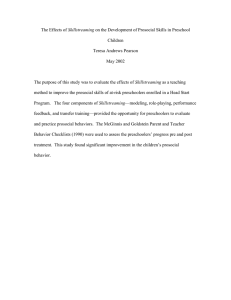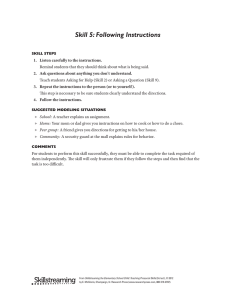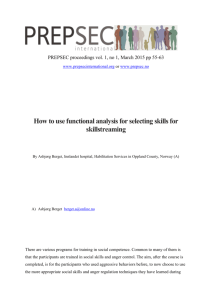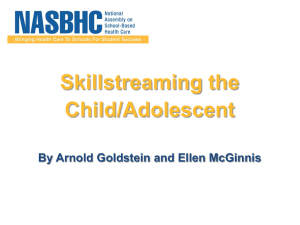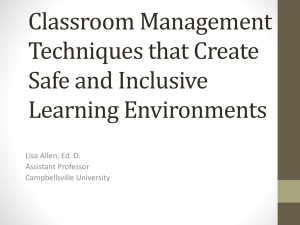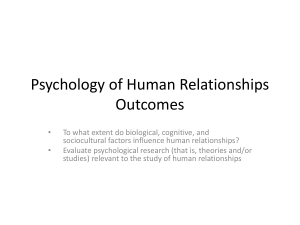Skillstreaming: Teaching Prosocial Skills to Children & Adolescents
advertisement
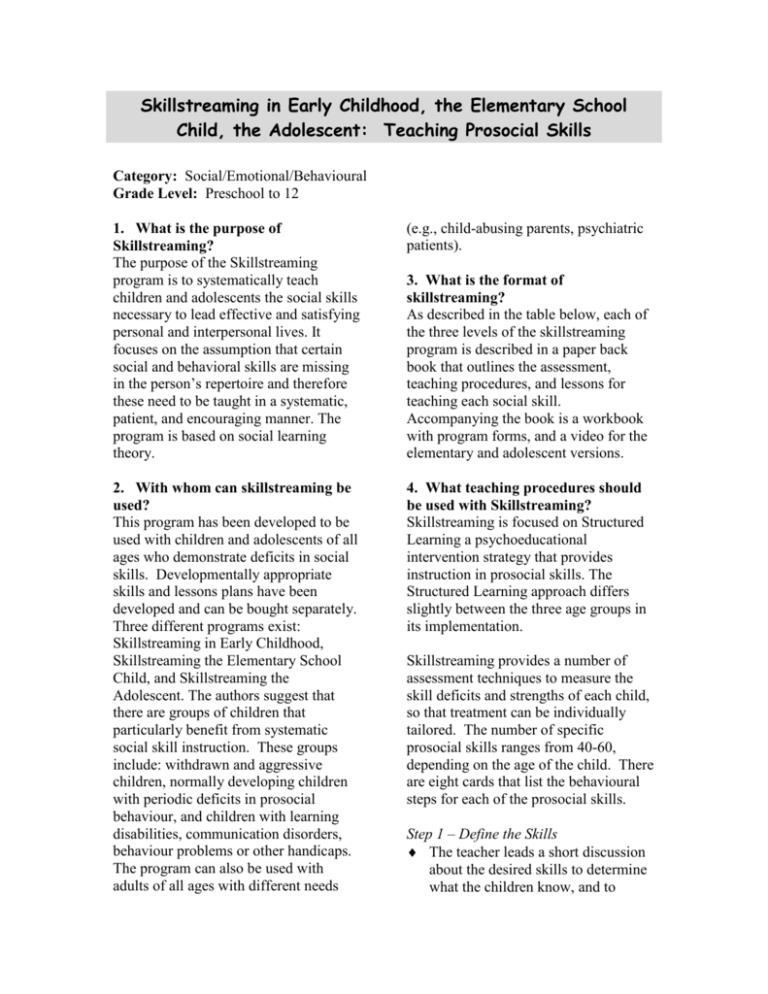
Skillstreaming in Early Childhood, the Elementary School Child, the Adolescent: Teaching Prosocial Skills Category: Social/Emotional/Behavioural Grade Level: Preschool to 12 1. What is the purpose of Skillstreaming? The purpose of the Skillstreaming program is to systematically teach children and adolescents the social skills necessary to lead effective and satisfying personal and interpersonal lives. It focuses on the assumption that certain social and behavioral skills are missing in the person’s repertoire and therefore these need to be taught in a systematic, patient, and encouraging manner. The program is based on social learning theory. (e.g., child-abusing parents, psychiatric patients). 2. With whom can skillstreaming be used? This program has been developed to be used with children and adolescents of all ages who demonstrate deficits in social skills. Developmentally appropriate skills and lessons plans have been developed and can be bought separately. Three different programs exist: Skillstreaming in Early Childhood, Skillstreaming the Elementary School Child, and Skillstreaming the Adolescent. The authors suggest that there are groups of children that particularly benefit from systematic social skill instruction. These groups include: withdrawn and aggressive children, normally developing children with periodic deficits in prosocial behaviour, and children with learning disabilities, communication disorders, behaviour problems or other handicaps. The program can also be used with adults of all ages with different needs 4. What teaching procedures should be used with Skillstreaming? Skillstreaming is focused on Structured Learning a psychoeducational intervention strategy that provides instruction in prosocial skills. The Structured Learning approach differs slightly between the three age groups in its implementation. 3. What is the format of skillstreaming? As described in the table below, each of the three levels of the skillstreaming program is described in a paper back book that outlines the assessment, teaching procedures, and lessons for teaching each social skill. Accompanying the book is a workbook with program forms, and a video for the elementary and adolescent versions. Skillstreaming provides a number of assessment techniques to measure the skill deficits and strengths of each child, so that treatment can be individually tailored. The number of specific prosocial skills ranges from 40-60, depending on the age of the child. There are eight cards that list the behavioural steps for each of the prosocial skills. Step 1 – Define the Skills The teacher leads a short discussion about the desired skills to determine what the children know, and to ensure they understand the skills that will be taught in the session. Step 2 – Model the Skill Each child receives a Skill Card where the each step is broken down into constituent parts/behavioral steps and is clearly defined. The group leader models all the behavioral steps, systematically in an expert manner, in at least two different examples. Examples must be relevant and modeling must display reinforced, positive outcomes. Models should “think aloud” through each of the behavioral steps. Step 3 – Establish Student Skill Need The group leader now facilitates a discussion to determine when and with whom the modeled skill should be used. Step 4 – Select Role-Player All children will role-play each skill taught. Step 5 – Set up the Role-Play The main actor chooses another student to play the other person; this person should remind the actor of the significant other to whom the skills is directed. A description of the setting, preceding circumstances, and mood is described by the main actor. Step 6 – Conduct the Role-Play The children role-play the skill “thinking aloud” each of the behavioral steps while the other children watch for the display of each step. Each child is then given an opportunity to do a role play as the main actor. Step 7 – Provide Performance Feedback A discussion is held to determine how well the actor adhered to the steps and to evaluate the effectiveness of the steps at accomplishing the desired goal. The group leader provides social reinforcement in the form of praise, encouragement, and approval when the actor has performed successfully; the facilitator should increase the reinforcement as the role-plays become closer approximations of the desired skills. Positive feedback should be provided first, and then proceeded by constructive negative feedback with suggestions for improvement. The child then can repeat the role-play to provide an opportunity for improvement. Step 8 – Assign Skill Homework Students are instructed to practice their newly acquired skill in real-life settings. There are three levels of homework: Level 1: The child thinks of a situation in which he or she feels the need to practice the skill. This situation is written on the Homework Report along with the skill name and steps. The child then uses the skill and evaluates how well they performed the skill steps. Level 2: When the child has achieved mastery of the skill, self-recording or monitoring is done independently throughout the week whenever the need arises. Self-evaluation is conducted on the sheet and the leader writes reinforcing comments on the form after a specified time period. Level 3: Numerous skills are listed on a cue card and the student keeps a tally of skill practice during the week. Group Self-Report Charts with stickers for each child can aid in the reinforcement of skills and homework completion. Skill contracts, self-recording forms, and skill awards (e.g., extra recess for the class) can also be used as motivation. Token reinforcers and tangible reinforcers can be used (e.g., stickers, activities, food). The following techniques are suggested to encourage the transfer of teaching: Ensure the child understands the rules and strategies that leads to success Overlearning Training loosely using multiple rolepays with different students Ensuring that the role-playing situations are as realistic as possible Ensure that the child him or herself is self-recording, self-reinforcing, self-punishing, and self-instructing. The following techniques are suggested to encourage maintenance: Unpredictable and slowly decreased reinforcement Delayed reinforcement Fade prompts Provide booster sessions Prepare for real-life nonreinforcement Program for natural reinforcement; use natural reinforcers 4. In what type of setting can Skillstreaming be used? Skillstreaming is a psychoeducational intervention that is primarily designed for use in school settings. It provides special education, general education and resource teachers, social workers, psychologists, and school counselors strategies for group instruction in prosocial skills. It can also be used in mental health and residential facilities. 5. To what extent has research shown Skillstreaming to be useful? Research has clearly demonstrated that systematic social skills interventions that are focused on specific skills are effective at teaching children necessary social skills. Social learning techniques have shown to be a successful way to teach these skills. This program improves on many in that it stresses and incorporates techniques to promote generalization. Skillstreaming was found to be effective in meeting the needs of the individual throughout development. References 1. Goldstein, A. P., & Goedhart, A. W. (1973). The use of structured learning for empathy enhancement in paraprofessional psychotherapist training. Journal of Community Psychology, 1, 168-173. 2. Goldstein, A. P. & McGinnis, E. (1990). Skillstreaming in early childhood: Teaching prosocial skills to the preschool and kindergarten child. Champaign, IL: Research Press. 3. Goldstein, A. P. & McGinnis, E. (1997). Skillstreaming the elementary school child: New strategies and perspectives for teaching prosocial skills (rev. ed). Champaign, IL: Research Press. 4. Goldstein, A. P., & McGinnis, E. (2001). Skillstreaming the adolescent: New strategies and perspectives for teaching prosocial 5. 6. 7. 8. skills. Champaign, IL. Research Press. Gutride, M. E., Goldstein, A. P., & Hunter, G. F. (1974). Structured learning therapy with transfer training to for chronic patients. Journal of Clinical Psychology, 30, 277-280. Kiburz, C. S., Miller, S. R. & Morrow, L. W. (1984). Structured learning using self-monitoring to promote maintenance and generalization of social skills across settings for a behaviorally disordered adolescent. Behavioral Disorders, 10, 47-55. McGinnis, E. & Goldstein, A. (2001). Skillstreaming the elementary school child: New strategies and perspectives for teaching prosocial skills. Champaign, IL. Research Press. McGinnis, E. & Goldstein, A. (1990). Skillstreaming in early childhood: Teaching prosocial skills to the preschool and kindergarten child. Champaign, IL: Research Press. 9. Sasso, G. M., Melloy, K. J., & Kavale, K. A. (1990). Generalization, maintenance, and behavioral covariation associated with social skills training through structured learning. Behavioral Disorders, 16, 9-22. 10. Schneider, B. H. (1992). Didactic methods for enhancing children’s peer relations: A quantitative review. Clinical Psychology Review, 12, 363-382. Website www.researchpress.com Reviewed by: Jasmine Eliav and Anna Simpson The format of skillstreaming. Three categories Materials Included Early Childhood Book Program Forms Booklet Adolescent 40 Specific Prosocial Skills Elementary school child Book Program Forms Booklet Skill Cards Student Manual Video 60 Specific Prosocial Skills Prosocial skills Skill Groups 6 Skill Groups 5 Skill Groups 6 Skill Groups 1. Beginning prosocial skills 2. School-related skills 3. Friendshipmaking skills 1. Classroom survival skills 2. Friendshipmaking skills 3. Dealing with feelings 1. Beginning social skills 2. Advanced social skills 3. Dealing with feelings Book Program Forms Booklet Skill Cards Student Manual Video 50 Specific Prosocial Skills 4. Dealing with feelings 5. Alternatives to aggression 6. Dealing with stress 4. Alternatives to aggression 5. Dealing with stress 4. Alternatives to aggression 5. Dealing with stress 6. Planning skills
